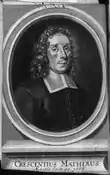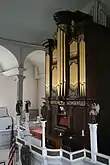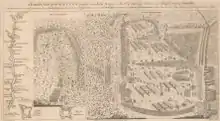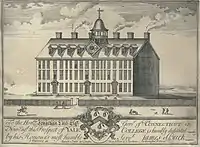Thomas Johnston (engraver)
Thomas Johnston (1708–1767) was an American engraver, japanner, and heraldic painter of Colonial Boston. He painted views of Boston and made plates of heraldic. He also made furniture and sold it for a business. He is noted for making the first historical print engraved in America. It was engraved on a copper plate and widely published by a well known printer and came with a history pamphlet.
Thomas Johnston | |
|---|---|
| Born | 1708 |
| Died | May 8, 1767 (aged 58–59) |
| Nationality | American |
| Occupation | Engraver |
| Known for | organ building, engraving |
Notable work | first American historical print engraved, which is a scene of the Battle of Lake George |
Johston was a church organ builder and is recognized for being the first person who manufactured church organs as a regular business in America. He was involved in constructing a large organ for the Old North Church in Boston that was used for over a hundred years.
Early life


Johnston was born in 1708 in Boston, Massachusetts.[1] He was an engraver, an ornamental painter, a japanner, a coats of arms painter, a book publisher, and a builder of organs.[2] He decorated clocks and furniture with embossed or raised work depicting Chinese images. He was a skillful engraver and heraldic painter. He sold London-style looking glasses of all sorts and sizes in 1732 as a japanner at the Golden Lyon on Ann Street, near Dock Square in downtown Boston.[3]
Mid-life and career
Johnston lived in a house on the west side of Brattle Square that he purchased in 1742.[4] The house was across the street from the tower of the Brattle Street Church, of which Johnston became a member on June 5, 1726. At the church, he was involved with various aspects of liturgical music.[3] His workshop, where he did painting, engraving, and organ construction, was in the backyard of his home.[5] He advertised himself as an engraver, painter, organ maker, and furniture merchant.[6] The Boston Museum of Fine Arts has a portrait of Increase Mather by Johnston, and the Massachusetts Historical Society also has one attributed to him.[4][7]
Johnston rented a small shop near the Town Dock, where he sold his paintings as well as engravings made with copper plates. He is noted for his engravings of views of Boston and Louisburg Square and plates of a heraldic character.[8] At his death items enumerated in his inventory were a book of heraldry valued at 48 shillings, 10 small pictures valuated at 30 shillings, glass arms valuated at 4 shillings, 2 pictures valued at 62 shillings, Dr Mayhew and Mr Gee's pictures valued at 36 shillings, 6 other pictures valued at 9 shillings, a large piece of an unfinished painting valued at 24 shillings, 4 small pictures valued at 2 shillings, two sundry pictures valued at 16 shillings, easel paint stones and brushes valued at 15 shillings, copper plates valued at 40 shillings, and an unfinished organ that no value was placed on.[9]
Johnston was the first person reported to have manufactured church organs as a regular business in Colonial America.[10] The Old North Church in Boston had an imported organ obtained originally by William Claggett in 1736.[11] The church made an agreement with Johnston in 1752 to purchase an American organ that would be as loud as that of Boston's Trinity Church, to replace Claggett's worn-out organ.[5] Johnston constructed the organ in 1758–1759.[4][12] This organ made by Johnston was used until 1886.[10][13]
Engravings

Johnston was a self-taught engraver. He engraved event scenes, views, trade cards, certificates, currency, plans, buildings, maps, music, and book illustrations.[14] His earliest known engraving work is his Plan of Boston of 1729, dedicated to Massachusetts Governor William Burnet.[1] His most notable apprentice was the artist John Greenwood.[15]
Johnston made the first historical print engraved in America,[16][17][18] a scene depicting a battle near Lake George in the north of the Province of New York. The battle scene was originally drawn by Samuel Blodgett – A prospective plan of the battle fought near Lake George on the 8th of September 1755 – who was a witness at the event.[19] Blodgett persuaded Johnston, well known as an engraver, to engrave his sketch on copper so that the printer Richard Draper could print it.[20] The scene was printed and published in Boston. It was sold by Blodgett starting on December 22, 1755.[21][22][23] Johnston's engraving of the Lake George battle shows, to the left, a bird's eye view of troops marching. To the right side of the engraving is a view of a camp and a battle. The map shows the Hudson River and plans of Fort William Henry and Fort Edward. The engraving was 13 5/8 by 17 1/2 inches (34.6 × 44.6 cm).[24] It came with an eight-page pamphlet that explained the historical event.[25] It was reprinted in London by Thomas Jefferys for publication in 1756, with the plan and the eight-page pamphlet.[26]
Some of Johnston's several dozen engravings include the following; the engraving of the first view of Yale College is one that made him famous.[27]

- Trade card of Thomas Hancock, 1727
- The fourth state of the Bonner map of Boston, 1732
- Trade card of Samuel Grant, 1736
- Manufactory notes issued in different values in the name of James Eveleth, 1741
- A Plan of Cape Breton, & Fort Louisbourgh, 1745
- Chart of Canada River from ye Island of Anticosty, 1746
- Prospect of Yale College, 1749
- A True Coppy from an Ancient Plan of E. Hutchinson's, 1753
- An "anchor and codfish" seal which he designed and engraved for the Plymouth Company in 1753.
- Plan of the Kennebeck and Sagadahock Rivers, 1753
- Plan of Hudson River from Albany to Fort Edward, 1756
- Clock face for Preserved Clap, 1756
- Province of Massachusetts-Bay officer's commission, 1758
- Fortification according to Mr. Blondel, 1759
- The Gentleman's Compleat Military Dictionary, 1759
- Quebec, The Capital of New-France, 1759
- The Grounds and Rules of Musick Explained, 1760
- A New Version of the Psalms of David, 1762
- Plan of ye Town of Pownall, 1763
- Walter's Grounds and Rules of Musick, 1764
- South Battery certificate of service, 1765
- John Gould junr a crown and sceptre advertisement on a signboard, 1765
- Bayley's Grounds and Rules of Musick, 1766
Marriages and children
Johnston married Rachel Thwing on June 22, 1730, and had eight children with her (five survived to adulthood).[4] His first wife died sometime in 1746. Johnston then married twenty-two-year-old Bathsheba Thwing, Rachel's cousin, on August 6, 1747.[4] He had three children with her; one was Samuel Johnston, a master mariner who drowned at sea in 1794 on a return trip from the West Indies.[3][28][29] Eight of his total of eleven children survived to adulthood and developed careers based on skills that were important in their father's work.[30][31]
Later life and death
Johnston died at the age of 59 in Boston of apoplexy on May 8, 1767. He is buried at the King's Chapel Burying Ground near King's Chapel church in Boston.[32] Three of his sons survived him.[33]
See also
American Colonial organ builders
American Colonial engravers
American Colonial printers
References
- Stauffer 1907, p. 144.
- Reps 1971, p. 83.
- Dunlap 1918, p. 312.
- Garraty 1999, p. 165.
- Williams 1915, p. 177.
- "Japanned Furniture: An 18th Century Faux Finish". The News Journal. Wilmington, Delaware. May 7, 1998. p. 48 – via Newspapers.com
 .
. - Murdock 1924, pp. 4-6.
- "Boston Folks' Coat of Arms". The Boston Daily Globe. Boston, Massachusetts. February 7, 1915 – via Newspapers.com
 .
. - "Herald Printer, No. 1 (Thomas Johnson)". The Heraldic Journal. 1–4: 6. 1865. Retrieved August 21, 2020.
- Owen 1979, p. 23.
- Ogasapian 2007, p. 59.
- "The OHS Pipe Organ Database". OHS Database ID 41284. The Organ Historical Society. 2016. Retrieved January 14, 2018.
- Babcock 1947, p. 140.
- Hitchings 1973, p. 83.
- Hitchings 1973, p. 85.
- Ciment 2016, p. 2596.
- Massachusetts Historical Society 1957, p. 260.
- New York State 1966, p. 10.
- New-York Historical Society 1969, p. 15.
- Green 1890, p. 4.
- Kane 1997, p. 18.
- Ramsey 1975, p. 568.
- Winsor 1887, p. 586.
- Exhibition Catalogs 1908, p. 46.
- Readex Books 1964, p. 245.
- NYPL 1964, p. 245.
- Library of Congress 1975, p. 59.
- Williams 1915, pp. 179–181.
- Williams, Cornelia. Ancestry of Lawrence Williams. Ann Arbor, Michigan: Hathi Trust.
- Reps 1971, pp. 117–122.
- The Society 1918, p. 406.
- Beers 1905, p. 572.
- "Obituary". Boston Evening Post. Boston, Massachusetts. May 11, 1767. p. 4.
Sources
- Babcock, Mary Kent Davey (1947). Christ Church, Boston. T. Todd.
- Beers, J. H. (January 1, 1905). Record of New London County, Connecticut. J.H. Beers & Company.
- Ciment, James (September 17, 2016). Encyclopedia of Colonial America. Taylor & Francis. ISBN 978-1-317-47416-6.
Thomas Johnston produces the first engraving of a historical event ever produced in America.
- Dunlap, William (1918). Arts of Design in the U.S. C.E. Goodspeed & Company.
- Exhibition Catalogs (1908). Exhibition Catalogs, 1886–1909: 1908–1909. Exhibition Catalogs.
- Garraty, John Arthur (1999). American National Biography. Oxford University Press. ISBN 978-0-19-512791-1.
- Green, Samuel A. (1890). Blodget's plan of the battle on the shores of Lake George, 8 September, 1755. Cambridge University Press.
- Hitchings, Sinclair (1973). Boston Prints and Printmakers. Colonial Society of Massachusetts.
- Kane, Joseph Nathan (1997). Famous First Facts. H.W. Wilson. ISBN 978-0-8242-0661-1.
the first historical print engraved in America was A-prospective-plan-of-the-battle-fought-near-Lake-George-on-the-8th-of-September-1755, which presented a birds eye view showing the march of troops at the left, the camp and battle at the right, and Forts William Henry and Edward in the upper right hand corner. It was a hand-colored line engraving by Thomas Johnston after a painting by Samuel Blodget, and was printed by Richard Draper in Boston, MA, in 1755.
- Library of Congress (1975). American Printmaking Before 1876. Library of Congress.
The late scholar I. N. Phelps Stokes noted that Blodget's picture was the 'first historical print engraved in America,' yet Blodget apparently saw his work as news, not history, and he had it ready for sale on December 22, 1755.
- Massachusetts Historical Society (1957). Massachusetts Historical Society. The Society.
The large engraved plan of the battle by Johnston has been called 'the first historical print engraved in America.'
- Murdock, Kenneth Ballard (1924). Portraits of Increase Mather + Notes on Thomas Johnson. W.G. Mathers. OCLC 877764605.
- New-York Historical Society, Library (1969). New-York Historical Society. New York Historical Society.
This is the first historical print engraved in America. Blodget witnessed the battle and immediately afterwards drew the original plan from which Thomas Johnson made the line engraving.
- NYPL (1964). New York Public Library bulletin. New York Public Library.
A-Prospective-Plan-of-the-Battle-fought-near-Lake-George-on-the-8th-of-September-1755. This plan, part map and part view, was engraved by Thomas Johnston and has the distinction of being the first historical print engraved in this country.
- New York State (1966). The Conservationist. N.Y.S. Environmental Department.
- Ogasapian, John (2007). Church Music in America, 1620–2000. Mercer University Press. ISBN 978-0-88146-026-1.
- Owen, Barbara (1979). The organ in New England: an account of its use and manufacture to the end of the nineteenth century. Sunbury Press. ISBN 978-0-915548-08-8.
- Ramsey, L. G. G. (June 1975). Complete color encyclopedia. Hawthorne Books. ISBN 978-0-8015-1538-5.
- Readex Books (1964). Bulletin of Research in the Humanities. Readex Books.
- Reps, John W. (1971). Boston Prints and Printmasters 1670–1775. University Press of Virginia.
- Stauffer, David McNeely (1907). Biographical sketches. Grolier club of New York City.
- The Society (1918). Colonial Society of Massachusetts. The Society. p. 406.
Thomas Johnston (1708–1767) three of Johnston's children followed their father's profession.
- Williams, Cornelia Bartow (1915). Ancestry of Lawrence Williams. R.R. Donnelley and Sons Co. p. 177.
His genius was versatile, for he was not only a japanner, heraldic painter and engraver, but also the pioneer organ builder in New England. He was undoubtedly the first person in New England, who undertook to construct church organs and who followed the business as a regular profession.
- Winsor, Justin (1887). Critical History of America. Houghton, Mifflin.
External links
| Wikimedia Commons has media related to Thomas Johnston. |